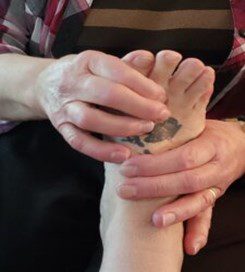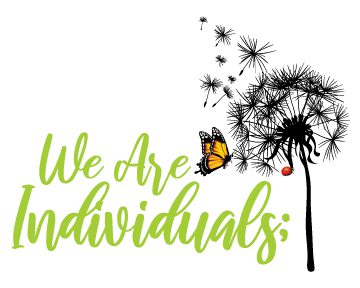Does Foot Reflexology Therapy help you with your Mental Health when it comes to anxiety, depression, or stress?
The answer to this question is… for a lot of people “yes” it does help, and it can be used as another tool in your “Mental Health Tool Kit.”
Apparently, getting a reflexology treatment does not only help anxiety, stress, and depression… it may even help one living with asthma, cancer, diabetes, headaches, poor kidney function, sinus issues, and it can even help you if you struggle with PMS.
What is Foot Reflexology Therapy?
 Foot Reflexology is a therapy that focuses on the different pressure points on your feet. It is a modality that stems back to Chinese medicine and has been used for centuries.
Foot Reflexology is a therapy that focuses on the different pressure points on your feet. It is a modality that stems back to Chinese medicine and has been used for centuries.
It is similar but not the same as a foot massage. Massages work on the tissues in one’s body. A reflexology treatment works on the nervous system of the body (it’s more internal based). There are 10 zones on your foot in Foot Reflexology, and there are 15 pressure points on your feet. Each pressure point on each of your feet corresponds to a certain organs or body parts. For example, there is a pressure point on your right foot that is the pressure point for your gall bladder, and there is a pressure point on your left foot that is the pressure point for your spleen. There are also pressure points on your feet that are connected to your arms, shoulders, waistline, lower back, hips, and knees…to name a few. The organs on the right side of the body have pressure points on the right foot, and the organs on the left side of the body have pressure points on the left foot. Pressure points for the lungs and kidneys are found on both your left and right feet.
The person that does Foot Reflexology treatments is called a reflexologist. The reflexologist (the person trained in this therapy) will have you sit in a comfortable chair, and then they will sit on a chair across from you. They will elevate your leg so that your foot can rest on their knee; then they will start to work on your foot and your calf…but focusing mainly on your foot. They will work on (massage) different areas of your foot starting at the toes (your big toe first) and working their way to your heel. Once they reach your heel, they will work up to your ankle bone a bit. After the practitioner finishes the ankle bone area, they start working on your calf up until they reach your knee. Once they reach your knee, they will move to your other foot and repeat the process all over again. Most Foot Reflexology treatments take about 30 minutes.
The technique the Foot Reflexologist uses is called “thumb walking.” The reflexologist uses their thumbs and fingers to “walk” across your foot applying pressure to break down toxins and open up energy blocks. Some of the things that get broken down by using this technique are the uric acid and calcium crystals that develop in your feet.
If you have “touchy” feet, you may find this treatment a little more challenging to get used to, but after a few treatments it usually gets easier…or you may not like it. If you don’t like people touching your feet you may want to choose a different alternative therapy… and that is okay too.
Remember, Foot Reflexology can be used as another tool in your “Mental Health Tool Kit.” Reflexology can help you with both physical and mental health challenges, and it can be used along with other modalities/therapies that are focused to help people with their anxiety, depression, and stress… but reflexology is not used to cure a disease and it is not used to diagnose any disease. It is a tool that is used to help the individual getting the treatment to relax and to alleviate some of their symptoms and sometimes even pain. Getting a reflexology treatment can even boost your immune system.
How does Foot Reflexology help the person getting the treatment?
Some of the very important things that a Foot Reflexology treatment does is it activates the nervous system, it relaxes the muscles and tendons, and it also gets the blood flowing through your feet. It also helps remove toxins in the body just like a massage. A reflexology session can even simulate around 7,000 or more different nerve endings. Getting a reflexology treatment can also improve nerve function, and it can increase the speed of healing by helping your cells regrow and heal faster. A Foot Reflexology treatment may even help your body destroy “bad cells” by stimulating the antioxidant activity in your body which can make the person feel better…
as the saying goes, “Happy feet… make happy people!“
Things to remember…
If you are getting a Foot Reflexology treatment, do not eat a heavy meal an hour before your treatment, and wait for at least an hour before eating after your treatment. Always make sure to drink water after a Foot Reflexology treatment because as mentioned above a treatment helps your body breakdown and release toxins and lactic acid, so in order to flush the toxins out of your body; therefore, you need to drink plenty of water.
How often should you get a Foot Reflexology treatment?
You can get a Foot Reflexology treatment once a week if you would like. I get a Foot Reflexology treatment when ever I feel I need one.
There are a few things you need to remember…Never get a Foot Reflexology treatment when you are pregnant because this could make you go into labour. Also, it is always a good idea to have a conversation with your family doctor if you have foot issues, injured blood vessels or a foot injury, blood clots in your legs, gout, or varicose veins before getting a Foot Reflexology treatment.
NOTE: Always make sure you research and find a registered practitioner.
If you are looking for a registered reflexologist, click on these links:
- In Canada: (click on the “For the Public” drop-down option)
https://www.reflexologycanada.org/en/what-is-reflexology
- In the United States:
Some Health/medical insurances provide coverage for the costs of different alternative therapies, so check with your insurance provider…they may cover a few sessions up to a specific dollar amount.
